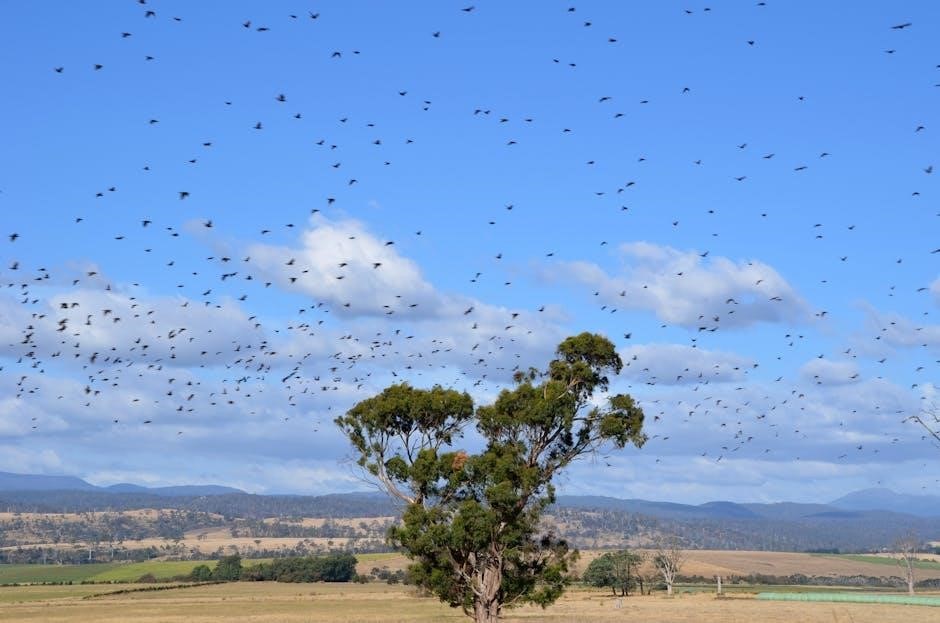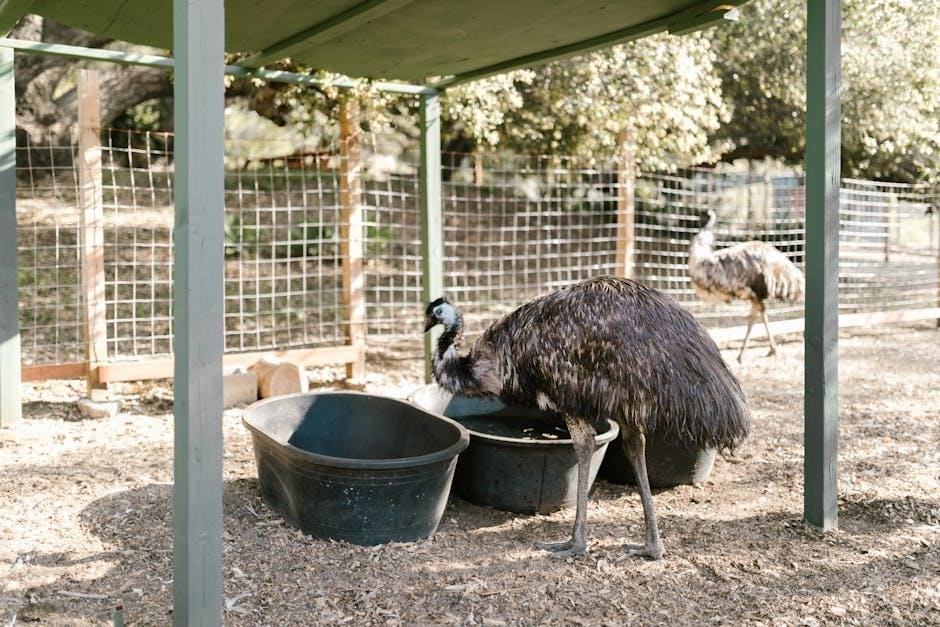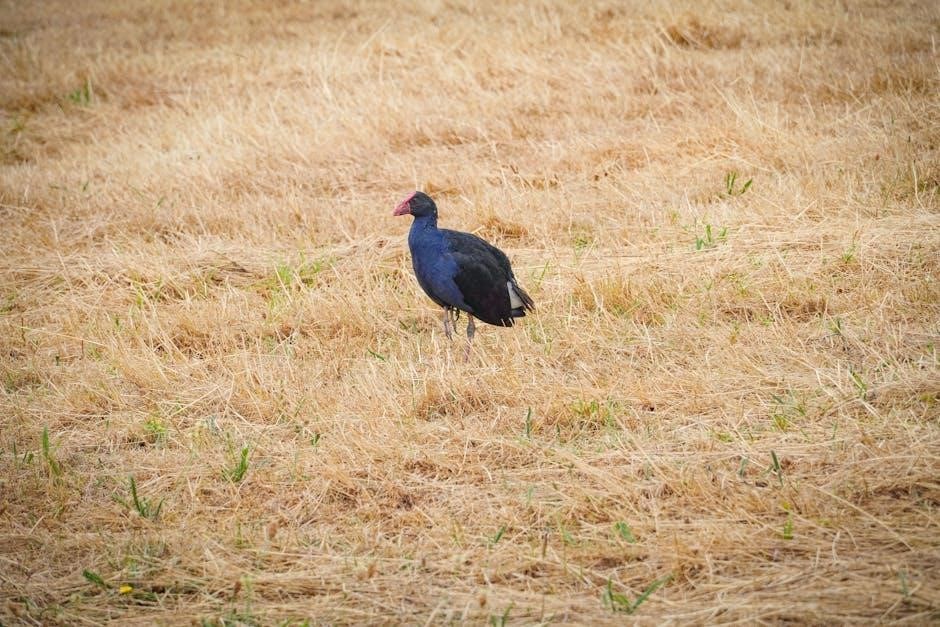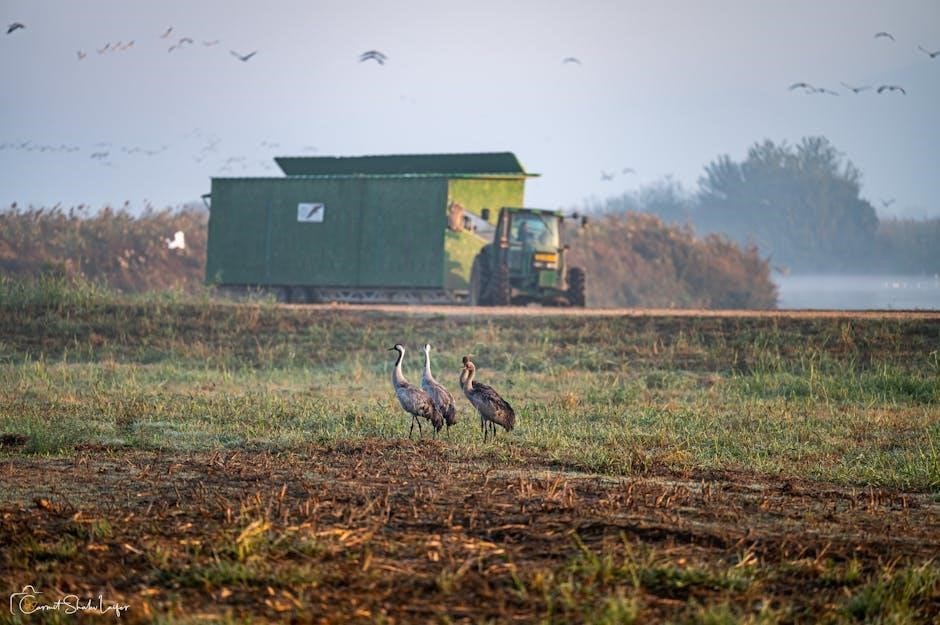Australian birdwatching is a captivating hobby, enhanced by field guides like Pizzey and Knight’s, which provide detailed insights into the country’s diverse avifauna, making identification accessible and enjoyable.
1.1 The Importance of Field Guides
Field guides are essential tools for Australian birdwatching, providing detailed descriptions, high-quality images, and identification tips. They enable birders to recognize species accurately, understand habitats, and appreciate behavioral traits. Guides like Pizzey and Knight’s and Simpson and Day’s are indispensable for both amateurs and experts, enhancing the overall birding experience.
1.2 Brief Overview of Australian Bird Diversity
Australia is home to over 800 bird species, many endemic due to its geographic isolation. From iconic birds like kookaburras and cockatoos to migratory species, the country’s diverse landscapes support a rich avifauna, making it a paradise for birdwatchers to explore and discover unique wildlife.

Popular Field Guides for Australian Birds
Renowned field guides like Pizzey and Knight’s, Simpson and Day’s, and the CSIRO Australian Bird Guide are indispensable resources, offering detailed species descriptions, vibrant imagery, and practical tips for bird enthusiasts.
2.1 Pizzey and Knight’s A Field Guide to the Birds of Australia
Pizzey and Knight’s guide is a trusted resource for Australian birdwatching, offering detailed descriptions, vibrant illustrations, and practical tips. Its user-friendly format and comprehensive coverage make it an essential tool for both novice and experienced birders, aiding in accurate species identification across diverse habitats.
2.2 Simpson and Day’s Field Guide to Australian Birds
Simpson and Day’s guide, now in its 7th edition, is renowned for its balance of detail and portability. It offers comprehensive descriptions, range maps, and vibrant illustrations, making it a favorite among birders. Its user-friendly layout aids in quick identification, catering to both novices and experienced enthusiasts across Australia’s diverse birding regions.
2.3 CSIRO Australian Bird Guide
The CSIRO Australian Bird Guide is widely regarded as the definitive resource, offering detailed descriptions, updated species information, and high-quality imagery. Its compact version enhances portability while maintaining comprehensive coverage, making it a favorite among birders for accurate and accessible identification in the field.
2.4 Simon Nevill’s Birds of Western Australia
Simon Nevill’s guide is celebrated for its accessibility and comprehensive coverage of Western Australia’s avifauna. It combines detailed descriptions with vibrant imagery, making it an indispensable resource for both seasoned birders and newcomers, ensuring accurate identification and deeper appreciation of the region’s unique bird species.

Bird Identification Tips
Bird identification relies on key traits like plumage, beak shape, size, and vocalizations. Observing these characteristics helps birders accurately distinguish species, enhancing their field guide experience and skills.
3.1 Key Characteristics for Bird Identification
Bird identification hinges on observing plumage patterns, beak shape, size, and vocalizations. These traits, detailed in field guides, help distinguish species accurately, ensuring precise recognition and a deeper understanding of Australia’s avifauna.
3.2 The Role of Plumage, Beak Shape, and Size
Plumage patterns, beak shape, and size are critical for bird identification. These traits, detailed in field guides, help distinguish species, as unique feather colors and beak forms adapt birds to specific habitats, aiding accurate recognition and understanding of ecological roles.
3.3 Vocalizations and Calls in Identification
Bird vocalizations are crucial for identification, as species often have unique calls. Field guides detail these sounds, helping enthusiasts recognize birds by their distinct songs, chirps, or whistles. Combining auditory cues with visual traits enhances accurate identification, especially for birds that resemble others in appearance.
Australian Bird Habitats and Ecosystems
Australia’s diverse habitats, from rainforests to deserts, support a wide range of bird species. Field guides like Pizzey and Knight’s help explore these ecosystems, linking birds to their environments.
4.1 Major Bird Habitats in Australia
Australia boasts diverse bird habitats, including rainforests, mangroves, grasslands, deserts, and wetlands. Field guides like Pizzey and Knight’s highlight how these ecosystems support unique avifauna, aiding birders in identifying species within their natural environments.
4.2 How Habitat Affects Bird Behavior and Distribution
Distinct habitats shape bird behavior and distribution, influencing foraging, breeding, and survival strategies. Field guides reveal how rainforests support secretive species, while open woodlands attract birds that forage in sunlight, underscoring habitat’s role in shaping avifauna diversity and ecological interactions across Australia.

Bird Behavior and Ecology
Bird behavior and ecology reveal fascinating insights into avian survival strategies, social interactions, and adaptations to diverse environments, as documented in field guides like Pizzey and Knight’s.
5.1 Migratory Patterns of Australian Birds
Australian birds exhibit diverse migratory patterns, with many species traveling between northern and southern regions seasonally. Some migrate to Southeast Asia, driven by food availability and climate. Field guides like Pizzey and Knight’s meticulously document these journeys, aiding birders in tracking and understanding these fascinating movements across the continent effectively.
5.2 Breeding and Nesting Habits
Australian birds display diverse breeding and nesting habits, from elaborate nests to simple ground-dwelling sites. Field guides reveal insights into species-specific behaviors, such as incubation periods, nest types, and parental roles. For example, songbirds often build cup-shaped nests, while others, like some waterfowl, nest directly on the ground, showcasing adaptation to their environments. This diversity highlights the complexity of avian reproduction and the importance of understanding these behaviors for effective birdwatching and conservation efforts.
5.3 Foraging and Feeding Behaviors
Australian birds exhibit varied foraging and feeding behaviors, adapting to their environments. Field guides detail how species like honeyeaters extract nectar with specialized beaks, while birds of prey hunt actively. These behaviors highlight unique adaptations, offering insights into ecological roles and survival strategies, essential for understanding avian diversity and behavior patterns effectively in the wild.
Conservation Status of Australian Birds
Field guides provide critical data on the conservation status of Australian birds, raising awareness about threatened species and promoting efforts to protect vulnerable populations effectively.
6.1 Threatened and Endangered Species
Field guides highlight Australia’s threatened bird species, such as the Gouldian Finch and Swift Parrot, providing insights into their declining populations. These resources emphasize the urgency of conservation, detailing habitat loss and climate impacts, and guide efforts to protect these vulnerable birds effectively.
6.2 Impact of Human Activity on Bird Populations
Human activities, such as deforestation, urbanization, and pollution, significantly threaten Australian bird populations. Habitat destruction disrupts ecosystems, while climate change alters breeding patterns. Field guides highlight these impacts, emphasizing the need for sustainable practices to protect vulnerable species and preserve biodiversity for future generations.
6.3 Conservation Efforts and Protected Areas
Australia has established extensive protected areas, including national parks and wildlife reserves, to safeguard bird habitats. Conservation initiatives, such as habitat restoration and community-led projects, aim to protect endangered species. Field guides like the CSIRO Australian Bird Guide support these efforts by raising awareness and promoting sustainable birdwatching practices nationwide.
Tools and Technology for Birdwatching
Essential tools include binoculars, spotting scopes, and birding apps like eBird. Camera traps and photography gear aid in documentation, while digital guides enhance species identification and tracking experiences.
7.1 Binoculars and Spotting Scopes
Binoculars and spotting scopes are indispensable for birdwatching, offering magnification and clarity. High-quality optics enhance bird identification, while durable designs withstand outdoor conditions, ensuring crisp views of distant or elusive species.
7.2 Birding Apps and Digital Guides
Birding apps and digital guides revolutionize birdwatching by offering instant access to species information, vocalizations, and high-quality images; User-friendly platforms allow quick identification, while GPS features help locate rare species, making them invaluable companions to traditional field guides like Pizzey and Knight’s.
7.3 Camera Traps and Photography in Birding
Camera traps and photography are essential tools for birding, offering high-quality images for identification and documentation. Motion-sensor technology captures rare species, while photography provides detailed insights into plumage and behavior, aiding research and conservation efforts, and sharing discoveries with the birding community.
Birding Hotspots in Australia
Australia’s diverse birding hotspots, from rainforests to deserts, offer rich habitats for over 800 species. Field guides like Pizzey and Knight’s aid enthusiasts in exploring these vibrant locations.
8.1 Top Birdwatching Locations
Australia’s premier birdwatching spots include Kakadu National Park, Daintree Rainforest, and the Blue Mountains. These locations offer diverse habitats, attracting species like eagles, parrots, and waterfowl. Coastal areas such as Hervey Bay and Rottnest Island also boast unique birdlife, making them must-visit destinations for enthusiasts, as highlighted in field guides like Pizzey and Knight’s.
8.2 Regional Variations in Bird Species
Australia’s birdlife varies significantly by region, with tropical species thriving in northern rainforests and arid-adapted birds inhabiting deserts. Coastal areas and urban centers host distinct populations, while unique endemics like the kookaburra and sulphur-crested cockatoo highlight regional diversity, documented in field guides for precise identification and exploration.
Seasonal Variations in Birdwatching
Seasonal changes influence bird behavior, habitats, and distribution, with field guides providing insights to track species migrations, breeding cycles, and plumage variations throughout the year.
9.1 Bird Migration Patterns by Season
Field guides reveal that Australian bird migration patterns vary seasonally, with species moving in response to climate, food availability, and breeding cycles. Spring and summer attract migratory birds, while autumn and winter see species seeking warmer or more resource-rich habitats, making seasonal awareness crucial for effective birdwatching.
9.2 Best Times for Birdwatching in Australia
The best times for birdwatching in Australia are during spring (September to November) and summer (December to February), when migratory species arrive and native birds are actively breeding. These seasons offer ideal weather conditions and increased bird activity, making them perfect for spotting a wide variety of species across different habitats.

Expert Tips for Amateur Birdwatchers
Use reliable field guides like Pizzey and Knight’s for accurate identification. Enhance observation skills by practicing patience and attention to detail. Keep a journal to track sightings and learn from experiences. Always follow ethical birdwatching practices to protect birds and their habitats.
10.1 Enhancing Observation Skills
Sharpen your birdwatching abilities by practicing patience and attention to detail. Use field guides to cross-reference sightings and note distinctive features like plumage, beak shape, and size. Pay attention to vocalizations, as calls are crucial for identification. Observing habitat preferences and behaviors can also enhance your birding experiences and improve accuracy.
10.2 Keeping a Birding Journal
Keeping a birding journal enhances your observations by recording species, habitats, and behaviors. Note dates, locations, and field guide references to track progress and refine identification skills. Sketches or photos add depth, fostering a deeper connection with Australia’s avifauna and promoting ethical birdwatching practices.
10.3 Ethical Birdwatching Practices
Ethical birdwatching involves minimizing disturbance to birds and their habitats. Use field guides responsibly, keep a safe distance, and avoid sharing sensitive locations. Respect nesting sites, refrain from feeding, and promote conservation efforts to protect Australia’s avifauna for future generations.
Field guides like Pizzey and Knight’s are essential for exploring Australia’s avifauna. They enhance birdwatching experiences, fostering deeper connections with nature and inspiring future conservation efforts.
11.1 The Future of Australian Birdwatching
The future of Australian birdwatching lies in advancing field guides, leveraging technology, and promoting conservation. Digital tools and apps will enhance identification and accessibility, inspiring new generations to explore and protect Australia’s avifauna, ensuring sustainable birding practices for years to come.
11.2 Encouraging New Generations of Birders
Engaging young birders through educational programs, digital tools, and mentorship is crucial. Field guides and birding apps inspire curiosity, while community events foster a sense of belonging, ensuring the hobby thrives by equipping the next generation with knowledge and passion for Australia’s avifauna.
